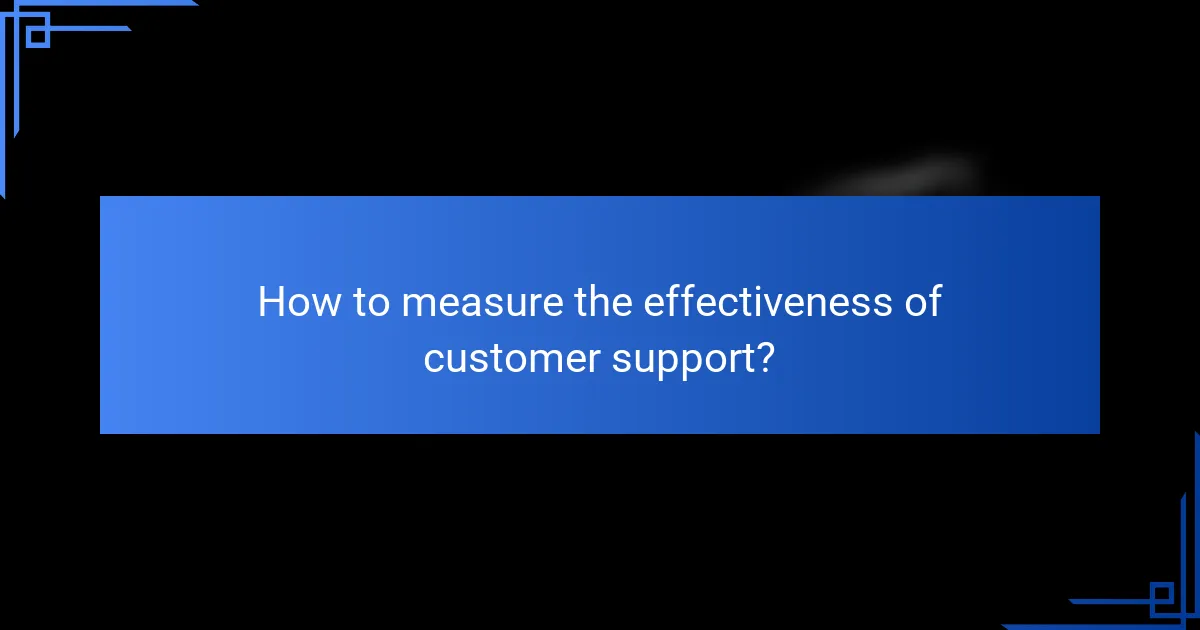Customer support plays a vital role in maximizing the value of subscription services by delivering timely assistance and resolving issues effectively. By fostering strong relationships with subscribers, effective support not only addresses immediate concerns but also cultivates loyalty and trust, essential for long-term success. Implementing best practices such as personalized communication and proactive outreach can significantly enhance customer satisfaction and retention.

How can customer support enhance subscription value?
Customer support can significantly enhance subscription value by providing timely assistance, resolving issues efficiently, and fostering strong relationships with subscribers. Effective support not only addresses immediate concerns but also builds loyalty and trust, which are crucial for long-term success.
Improved customer retention
Strong customer support leads to improved retention rates by ensuring subscribers feel valued and heard. When customers receive prompt and effective assistance, they are less likely to cancel their subscriptions, as their needs are met and frustrations are alleviated.
To maximize retention, companies should implement proactive support strategies, such as regular check-ins and personalized communication. Offering multiple channels for support, like chat, email, and phone, can also cater to different customer preferences.
Increased customer satisfaction
Customer satisfaction is directly linked to the quality of support provided. When subscribers experience quick resolutions to their issues, their overall satisfaction with the service increases. This positive experience can lead to favorable reviews and recommendations.
To enhance satisfaction, businesses should focus on training support staff to be knowledgeable and empathetic. Implementing feedback loops, where customers can share their experiences, can help identify areas for improvement and reinforce a customer-centric approach.
Higher lifetime value
Higher lifetime value (LTV) is achieved when customers remain loyal over time, often resulting from exceptional support experiences. Satisfied customers are more likely to upgrade their subscriptions or purchase additional services, thereby increasing their overall value to the company.
To boost LTV, companies should consider loyalty programs or incentives for long-term subscribers. Regularly analyzing customer data can help identify trends and opportunities for upselling or cross-selling, ensuring that support teams are aligned with sales strategies.

What are best practices for customer support in subscriptions?
Best practices for customer support in subscriptions focus on enhancing customer satisfaction and retention through effective strategies. Key approaches include personalized communication, proactive outreach, and multi-channel support to address customer needs efficiently.
Personalized communication
Personalized communication involves tailoring interactions based on individual customer preferences and history. This can include using the customer’s name, referencing past interactions, and suggesting relevant products or services. Such an approach fosters a deeper connection and improves customer loyalty.
To implement personalized communication, utilize customer data to segment your audience and create targeted messaging. For example, sending tailored emails based on previous purchases can significantly enhance engagement and response rates.
Proactive outreach
Proactive outreach means anticipating customer needs and addressing potential issues before they arise. This can include regular check-ins, updates on subscription changes, or reminders about upcoming renewals. By being proactive, you can reduce churn and enhance customer satisfaction.
Consider setting up automated notifications or follow-up emails to remind customers of important dates or offer assistance. This not only shows that you care but also helps customers feel valued and informed about their subscriptions.
Multi-channel support
Multi-channel support provides customers with various ways to reach out for assistance, including phone, email, live chat, and social media. This flexibility ensures that customers can choose their preferred method of communication, which can lead to quicker resolutions and higher satisfaction rates.
To optimize multi-channel support, ensure that all channels are integrated, allowing for seamless transitions between them. For instance, if a customer starts a conversation on social media, they should be able to continue it via email without losing context. This cohesive experience is crucial for effective customer support.

How to measure the effectiveness of customer support?
Measuring the effectiveness of customer support involves assessing various metrics that reflect customer experiences and satisfaction. Key indicators include customer satisfaction scores, net promoter scores, and response time metrics, each providing insights into how well support teams are performing.
Customer satisfaction scores
Customer satisfaction scores (CSAT) gauge how satisfied customers are with the support they receive. Typically measured through surveys immediately following a support interaction, these scores are often expressed as a percentage, with higher percentages indicating greater satisfaction.
To effectively use CSAT, consider setting a benchmark based on industry standards. For many sectors, a CSAT score above 80% is generally considered good. Regularly analyzing trends in these scores can help identify areas for improvement.
Net promoter score
The net promoter score (NPS) measures customer loyalty by asking how likely customers are to recommend your service to others. Responses are categorized into promoters, passives, and detractors, allowing you to calculate a score that ranges from -100 to +100.
A positive NPS, typically above 0, indicates more promoters than detractors. To enhance NPS, focus on addressing feedback from detractors and engaging with promoters to foster loyalty. Regular tracking of NPS can reveal shifts in customer sentiment over time.
Response time metrics
Response time metrics assess how quickly customer support teams address inquiries. Commonly measured in minutes or hours, these metrics can significantly impact customer satisfaction. Aim for response times that align with customer expectations, which often range from a few minutes for chat support to a few hours for email.
To improve response times, implement tools like chatbots for initial inquiries and prioritize tickets based on urgency. Regularly review these metrics to identify bottlenecks and optimize staffing levels during peak times, ensuring timely support for customers.

What tools can optimize customer support?
To optimize customer support, businesses can leverage various tools designed to enhance efficiency and improve customer interactions. Key tools include ticket management systems, live chat solutions, and customer relationship management (CRM) integrations, each serving distinct purposes in streamlining support processes.
Zendesk for ticket management
Zendesk is a widely used platform for managing customer support tickets, allowing teams to track, prioritize, and resolve customer inquiries effectively. It provides a centralized dashboard where agents can view all incoming requests, categorize them, and assign them to the appropriate team members.
Consider implementing automated responses for common issues to reduce response times. Additionally, utilizing Zendesk’s reporting features can help identify trends in customer inquiries, enabling proactive support strategies. Ensure your team is trained to use the platform efficiently to avoid common pitfalls like ticket backlog.
Intercom for live chat
Intercom offers a robust live chat solution that enables real-time communication between customers and support agents. This tool allows businesses to engage with users directly on their website or app, providing immediate assistance and enhancing customer satisfaction.
Utilize Intercom’s automated messaging features to greet visitors and guide them to relevant resources. It’s crucial to balance automation with human interaction; ensure that customers can easily reach a live agent when needed. Monitor chat metrics to refine your approach and improve response times.
HubSpot for CRM integration
HubSpot serves as a comprehensive CRM platform that integrates customer support with sales and marketing efforts. This integration allows support teams to access customer history and preferences, facilitating personalized interactions and efficient issue resolution.
When using HubSpot, ensure that all customer interactions are logged to maintain a complete view of each customer’s journey. Regularly update your CRM data to reflect changes in customer status or preferences. This practice not only enhances support effectiveness but also aids in identifying opportunities for upselling or cross-selling.

What role does training play in customer support?
Training is essential in customer support as it equips agents with the skills and knowledge necessary to effectively assist customers. A well-trained support team can significantly enhance customer satisfaction and loyalty, ultimately benefiting subscription-based businesses.
Skill development for agents
Skill development focuses on enhancing the capabilities of customer support agents through targeted training programs. This can include communication skills, problem-solving techniques, and product knowledge. Regular workshops and role-playing scenarios can help agents practice and refine these skills in a safe environment.
Investing in skill development leads to faster resolution times and improved customer interactions. Companies should consider ongoing training sessions to keep skills sharp and adapt to new challenges in customer support.
Knowledge base creation
A comprehensive knowledge base is a vital resource for customer support teams, providing quick access to information about products and services. This centralized repository allows agents to find answers efficiently, reducing response times and improving service quality. Regular updates and contributions from experienced agents can keep the knowledge base relevant and useful.
Encouraging agents to document solutions to common issues can enhance the knowledge base. This practice not only aids new team members but also fosters a culture of continuous learning and improvement within the support team.
Onboarding programs
Effective onboarding programs are crucial for integrating new customer support agents into the team. A structured onboarding process should include training on company policies, tools, and customer interaction protocols. This ensures that new hires are well-prepared to handle customer inquiries from day one.
Mentorship from experienced agents can further enhance the onboarding experience. Pairing new hires with seasoned team members allows for real-time feedback and guidance, helping them to acclimate more quickly and effectively to their roles.

How can customer feedback improve support?
Customer feedback is essential for enhancing support services, as it provides direct insights into user experiences and expectations. By systematically collecting and analyzing feedback, businesses can identify areas for improvement, tailor their support strategies, and ultimately increase customer satisfaction.
Collecting Feedback Effectively
To gather valuable customer feedback, utilize various channels such as surveys, social media, and direct communication. Online surveys can be particularly effective, with response rates typically ranging from 10% to 30%, depending on the method used. Ensure that questions are clear and focused to elicit specific insights.
Consider implementing tools like Net Promoter Score (NPS) or Customer Satisfaction Score (CSAT) to quantify feedback. These metrics can help track customer sentiment over time and identify trends that may require attention.
Analyzing Feedback for Insights
Once feedback is collected, analyze it to uncover patterns and common issues. Use qualitative methods such as thematic analysis to categorize comments and identify recurring themes. Quantitative data can be visualized through charts to highlight significant trends.
Focus on actionable insights that can lead to tangible improvements. For example, if multiple customers report long wait times, consider optimizing staffing or implementing a callback system to enhance efficiency.
Implementing Changes Based on Feedback
After analyzing feedback, prioritize changes that will have the most significant impact on customer satisfaction. This may involve training staff, updating support materials, or enhancing technology. Aim for quick wins that can be implemented in the short term, alongside longer-term strategic changes.
Communicate changes to customers to show that their feedback is valued. This can foster loyalty and encourage further engagement, as customers appreciate when their input leads to tangible improvements.
